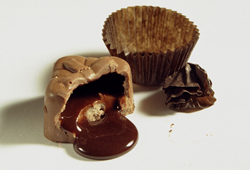The good life: craving cacao
A guide to buying (and eating) the world's best chocolate

The most important rule of chocolate-tasting is also the most difficult to follow: no chewing.
“The best way to taste chocolate is to put it on your tongue and let it melt,” says Kara Nielsen, a senior staff assistant in BU’s culinary certificate program, who should know — she used to work for the Scharffen Berger chocolate company in Berkeley, Calif. “You’re looking for first flavors, acid, tannins, earthy tones, and texture. The more finely ground the chocolate is, the smoother and creamier the mouth feel.”
Nielsen led a chocolate-tasting session at Metropolitan College’s Place, Taste, and Sustenance conference in June, and surprised chocolate lovers by showing them that even extra-bitter chocolate — like the Scharffen Berger Unsweetened, with a 99 percent cacao content — can be pretty palatable, depending on your tastes and needs. The participants tasted 13 chocolates from different manufacturers, including Callebaut, El Rey, and Valrhona.
Try white and milk chocolate when a sweet taste and creamy texture are important. Traditionally, Nielsen says, milk and sugar were added to chocolate to mask poor quality. These days, manufacturers offer better options, making white and milk chocolates great for snacking and cooking. El Rey, a company based in Venezuela, makes a white chocolate (which is technically not chocolate, since it has no cacao) from the cocoa butter of criollo beans and a milk chocolate with 41 percent cacao — the highest percentage of any milk chocolate, Nielsen says. Both types are sweet and smooth-textured, making them easy to work with in pastry and mousse.
Taste-test the melting point. Bittersweet chocolate is great for baking, and the variety of cacao content in different brands offers a lot of tasting options. To find out whether a chocolate melts quickly and easily or is more resilient, try a small piece and see how long it takes to melt in your mouth. Trader Joe’s sells a bittersweet 54 percent bar and Scharffen Berger an unsweetened 99 percent, both of which are great in recipes, Nielsen says.
Experiment with flavor. The questions to ask when tasting chocolate: is the flavor fruity, acidic, or dull? Is the texture clean or grainy and dry? And what flavors emerge as it melts in your mouth? The key, Nielsen says, is to “think about why you’re buying it,” and the fun part is buying lots of small batches to try out different flavors. Keep in mind that some of the best chocolate in the world is very different from what American buyers are accustomed to. “It’s sort of like a difficult child,” Nielsen says of specialty chocolate. “After a while you discover all of its charms.”